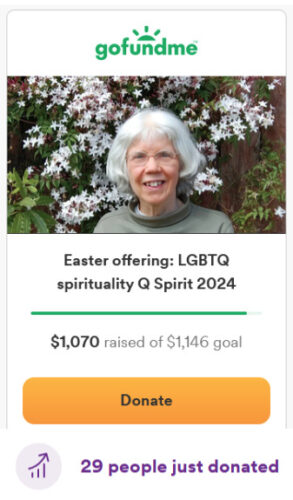Last Updated on January 13, 2024 by Kittredge Cherry

Q Spirit founder Kittredge Cherry was interviewed about LGBTQ Christian art, saint, history and theology for a Sunshine Cathedral video on June 24.
A video of the interview is available on Facebook and YouTube.
She puts various LGBTQ saints into the context of current events, does show-and-tell about two gay Jesus artworks that hang in her home, and shares her own spiritual journey in the 46-minute video.
Kitt was interviewed live on Facebook by Durrell Watkins, senior minister of Sunshine Cathedral, which bills itself as “America’s queer church for all” and is based in Fort Lauderdale, Florida. She is one of the “queer spiritual rock stars” that Watkins interviewed during Pride Month for his weekly Share in the Chair series.
“I’m always in awe of the knowledge she has,” says the most popular comment on the video at Facebook.
One viewer described Kitt as “the lesbian Sister Wendy,” comparing her to Sister Wendy Beckett, a nun known for her books and BBC/PBS television series on great world art.
Audrey Lockwood, Kitt’s spouse, did a fantastic job behind the scenes, moving art and books in and out of the video seamlessly throughout the interview.
The following summary of Kitt’s interview provides the highlights in chronological order as discussed on the video.
Introducing Kittredge Cherry
Durrell warmly welcomes Kitt and introduces her:
“She is an art historian. She’s a theologian. She studied journalism even before all of that. She was a staff minister at MCC San Francisco in the Eighties during the beginning and height of the AIDS crisis, so she was in the battlefield for sure. And then she moved a little south to LA to be the ecumenical officer for Metropolitan Community Churches, our voice in inter-religious and ecumenical dialogue in the world. She has written about seven books. She’s a blogger. And she is the founder and publisher at Qspirit.net. For years before that she did something called Jesus in Love at Jesusinlove.org, but now it’s Qspirit.net, a wonderful resource, especially for LGBTQ+ clergy and our allies. It’s a resource that I depend on, and have for about a decade… I’m so excited. You’re one of the people that I’ve wanted to talk to forever on this show — and here you are!”
Queer martyrs in a time of protest
Thousands of queer martyrs were executed throughout history for homosexuality or gender nonconformity. Many executions were fueled by religion-based hate, although the church was relatively tolerant of homosexuality during its first 1,000 years. The death penalty for homosexuality continues in at least 10 countries.
I want to place it in the context of this particular time, with the protests over racist police violence and the killing of George Floyd by having here with me a small image of “Jesus of the People” by Janet McKenzie. She used an African American woman as a model and painted a black Jesus who was androgynous — or genderqueer. A protestor left a print of this painting at the George Floyd memorial in Minneapolis on the hallowed ground where he died. It’s important to see Jesus as one of us — and also important to see Jesus looking like others, especially other oppressed groups. It enlarges the way we see God. This outsider Christ, this liberator is with us now as we speak.
Lesbian goddesses shape images of the Virgin Mary
Goddesses were worshiped in many ancient cultures, including by the Greeks and Romans, and indigenous cultures today. Christianity came along, and those goddesses were mixed with Mary. Purists on both sides don’t like that. Other people like me see them as enriching each other.
One example is the Roman goddess Diana, or Artemis in Greek. She is sometimes called a lesbian goddess because of her love for woman and her vow never to marry a man. Her midsummer festival was adapted into Mary’s Feast of the Assumption on Aug. 15.
Another example is Erzulie Dantor, a Haitian goddess who protects lesbians. Images of her were developed by Africans brought to Haiti to work on coffee and sugar plantations. They mixed their spiritual traditions with the Black Madonna of Czestochowa, who was brought to Haiti by Polish soldiers. That created one of the Black Madonnas that can inspire us today.
This process continues. For example, Our Lady of Guadalupe is a Mexican vision of the Madonna, and artist Alma Lopez has created lesbian visions of Guadalupe.
Christianity inspired Kitt to come out as a lesbian
Durrell asks, “Were you always this sort of universalist, pluralistic witness that you are today?”
After a mostly secular upbringing in the Midwest, Kitt discovered the reality of God as an adult while living in Japan. She felt God reach out to her at an inter-denominational English-speaking church in Kobe.
She has always been interdenominational, so she felt right at home in Metropolitan Community Churches, which brings together LGBTQ people from many Christian traditions.
“I knew I was a lesbian before I knew there was God. I felt that God wouldn’t have reached out to me like that if God didn’t love lesbians and gay men. So it was really God’s love and Christianity that helped me come out as a lesbian and tell others. Before that I was living in secret about it.”
Montevergine Madonna helped queer people in medieval times
The Madonna of Montevergine miraculously rescued a male couple who were condemned to death in medieval Italy. They were probably femminielli, a third-gender group that has a traditional place of acceptance in the Naples area.
Divine kiss shows the holiness of LGBTQ love
Jesus and a Hindu god kiss in an artwork that give people the freedom to experience God in new ways. Art can open the heart in a way that traditional texts may not.
Being human as well as divine, Jesus must have had sexual feelings. Nobody knows for sure whether the historical Jesus was attracted to other men. Some Bible scholars do think so.
Art like this helps gay and lesbian people accept ourselves and see our love as holy, even when conservatives call us sinners. The Bible does NOT condemn loving, responsible homosexual relationships.
“Jesus and Lord Rama” by Alex Donis has been controversial since it was first exhibited in San Francisco 1997. People were so upset that they broke into the gallery and smashed it.
I still get hate mail because it’s on my Q Spirit blog, especially from Hindu fundamentalists. No disrespect is intended. I believe that being gay is good, so it’s not an insult to Hindus. I’m not trying to convert Hindus to Christianity.
The gay Jesus is necessary because conservatives are using Christian rhetoric to justify hate and discrimination against LGBTQ people.
Why do people get upset about gay Jesus?
Controversy continues over the gay Passion of Christ paintings by Doug Blanchard. They show Jesus as a gay man of today in a modern city as he goes through Palm Sunday, Last Supper, arrest, trial, crucifixion, resurrection, appearances to disciples, and the most controversial images in the afterlife where Jesus has a homoerotic embrace with God. The most recent blow-up was last fall when Vatican advisor and Jesuit priest James Martin tweeted it. Breitbart and others ran attack articles.
Conservatives attack paintings of a gay Jesus, but Jesus loved everyone, including sexual minorities and outcasts.
Every community presents Jesus in their own way. There’s black Jesus, woman Christ, Asian Jesus — and now gay Jesus. The Bible gets translated into many languages, and now we get to hear the gospel in gay.
The reason they get upset is because they use religion to hide their bigotry. If that’s taken away, they have to face their own prejudice and change.
Another reason they get upset is: Anytime you make Jesus contemporary and real, it’s a threat to the status quo. He taught radical love, and was killed for it then. The living Christ still embodies radical love and it’s STILL a threat.
See Q Spirit for yourself
Durrell urged people to check out Kitt’s books and website: “I keep talking about Q Spirit. There’s this calendar of saints, there’s the Litany of Saints, there’s contemporary heroes, there’s all this great artwork, there’s blog posts — and you share this on other social media a lot. So people can go to Qspirit.net and see all this for themselves and learn so much.
Everyone is invited to visit Qspirit.net to read articles and sign up for the free monthly Q Spirit newsletter.
The artwork discussed today is in “Art That Dares: Gay Jesus, Woman Christ, and More” by Kittredge Cherry. The illustrated book was nominated for a Lambda Literary Award. It is filled with art by 11 contemporary artists from the U.S. and Europe. Her other books include “The Passion of Christ: A Gay Vision” with art by Doug Blanchad and “Equal Rites: Gay and Lesbian Worship, Ceremonies, and Celebrations.”
What happens when we die?
Durrell always ends his interview show by asking: “What happens when we die?”
Kitt responds by telling how conservatives got upset when James Martin warned them: You may be surprised when you get to heaven and are greeted by LGBT people!
Of course, we may be surprised to see conservatives there when we get to heaven!
Nobody knows, but I do believe we will be greeted by saints and loved ones — including our animal companions who wait for us at the Rainbow Bridge.
I think of I Corinthians 13: “For now we see through a glass, darkly; but then face to face: now I know in part; but then shall I know even as also I am known.”
Now we’re doing this interview over Zoom, through the glass of cameras and computer screens. We communicate, but we can’t REALLY touch each other.
Kitt: “When we’re both in heaven, Durrell, we’re going to really be able to see each other face to face and know each other in all our beauty along with all our loved ones in heaven, and all of it in God’s loving presence..”
Durrell: “I’ll take it. Sign me up!”
The interview ends with an exchange of blessings based on the Rainbow Christ Prayer:
Kitt: May the Rainbow Christ be with you!
Durrell: And also with you!
___
This post is part of the LGBTQ Saints series by Kittredge Cherry. Traditional and alternative saints, people in the Bible, LGBT and queer martyrs, authors, theologians, religious leaders, artists, deities and other figures of special interest to lesbian, gay, bisexual and transgender and queer (LGBTQ) people and our allies are covered.
This article was originally posted on June 27, 2020, and was most recently updated on Oct. 3, 2022.
Copyright © Kittredge Cherry. All rights reserved.
Qspirit.net presents the Jesus in Love Blog on LGBTQ spirituality.







